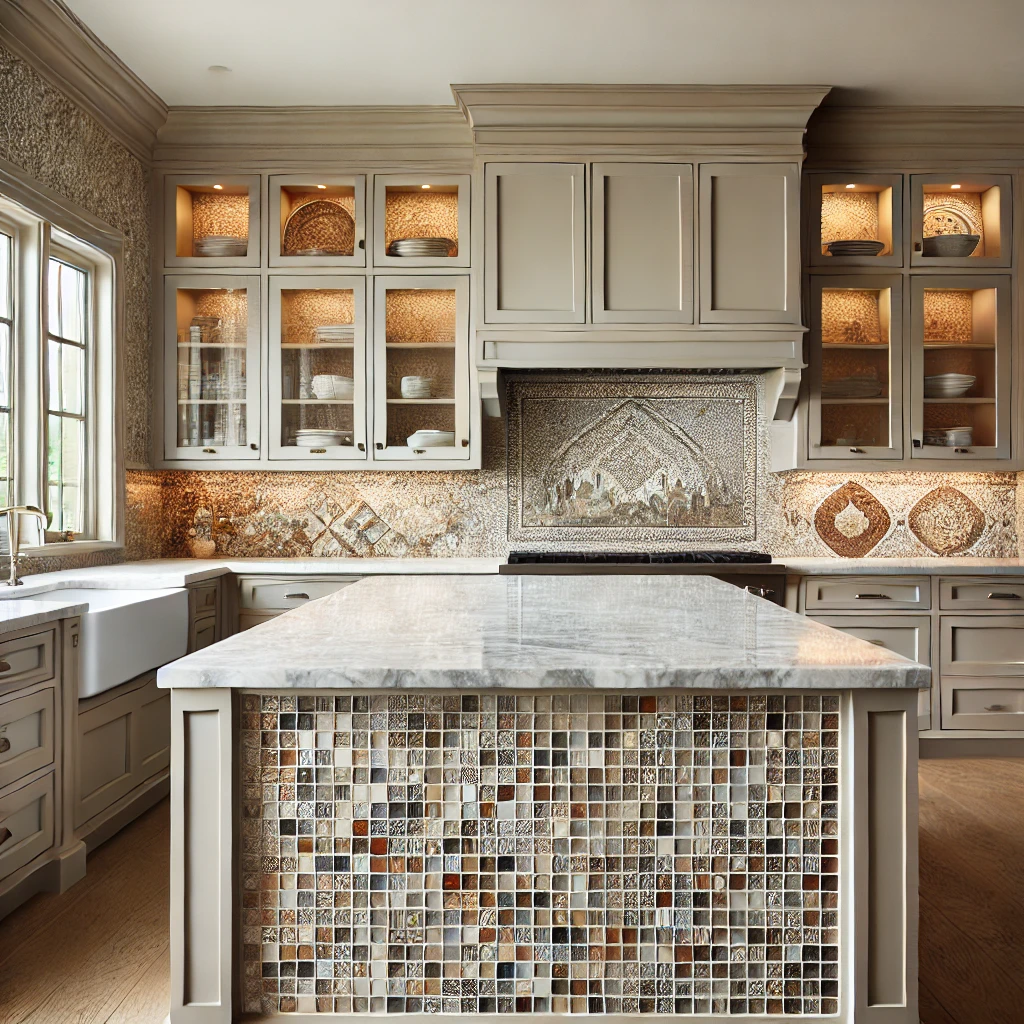Mosaic tiles are an excellent way to add style, texture, and color to any kitchen. Whether you’re aiming for a modern, rustic, or traditional look, mosaic tiles can be tailored to suit a variety of design preferences. Their versatility and durability make them particularly suitable for kitchen environments, where both aesthetics and functionality are key. In this article, we’ll explore various ways to incorporate mosaic tiles into kitchen decor, highlighting their benefits, design ideas, and practical considerations.
1. Creating a Striking Backsplash
One of the most popular ways to use mosaic tiles in the kitchen is as a backsplash. A mosaic backsplash can serve as both a functional element—protecting walls from splashes and spills—and a decorative focal point that enhances the overall aesthetic of the kitchen.
Design Ideas:
- Vibrant Patterns and Colors: Choose mosaic tiles in vibrant colors and bold patterns to create a lively and dynamic backsplash. Consider using a mix of glass, ceramic, and metallic tiles to add depth and visual interest.
- Subtle Elegance: For a more understated look, opt for neutral tones or monochrome mosaics that complement the kitchen’s color scheme. Subway tiles arranged in a herringbone or chevron pattern can add a touch of elegance without overwhelming the space.
- Artistic Mural: Consider creating a custom mosaic mural as your backsplash, depicting scenes from nature, abstract designs, or cultural motifs. This can turn your kitchen into a unique work of art.
Practical Considerations:
- Ease of Cleaning: Choose mosaic tiles that are easy to clean, as the backsplash is prone to food splatters and grease. Glass and ceramic tiles are particularly easy to wipe down.
- Grout Maintenance: Ensure that the grout is properly sealed to prevent staining and ease the cleaning process. Darker grout colors can be more forgiving when it comes to stains.
2. Enhancing Countertops with Mosaic Inlays
Mosaic tiles can also be used to enhance kitchen countertops. Whether you want to add a decorative border, a central medallion, or even cover the entire countertop, mosaic tiles can add a unique touch to your kitchen surfaces.
Design Ideas:
- Decorative Borders: Add a mosaic border around the edge of your countertop to create a frame that ties in with other design elements in the kitchen. This can be particularly effective with natural stone or wood countertops.
- Central Medallion: Incorporate a mosaic medallion in the center of a large island or countertop to create a focal point. Choose colors and patterns that complement the overall kitchen decor.
- Full Countertop Coverage: For a bold statement, consider covering the entire countertop with mosaic tiles. This works especially well in kitchens with a more eclectic or artistic style.
Practical Considerations:
- Durability: Ensure that the mosaic tiles used on countertops are durable and able to withstand heavy use. Porcelain, ceramic, and natural stone tiles are good options for this application.
- Maintenance: Countertops are prone to spills and stains, so choose tiles that are easy to clean and maintain. Sealing the tiles and grout is essential to protect against moisture and staining.
3. Accenting Kitchen Islands and Bars
Kitchen islands and bars are often the centerpiece of the kitchen, making them ideal spots for incorporating mosaic tiles. Using mosaics in these areas can add color, texture, and visual interest to your kitchen design.
Design Ideas:
- Island Base Accents: Cover the base of your kitchen island with mosaic tiles to create a decorative element that stands out. This is a great way to add a pop of color or a unique pattern to the kitchen.
- Bar Fronts: If your kitchen includes a bar area, consider using mosaic tiles on the front or sides. This can create a stylish, inviting space for entertaining guests.
- Contrasting Colors: Use mosaic tiles in contrasting colors or materials to set the island or bar apart from the rest of the kitchen, making it a true focal point.
Practical Considerations:
- Durability: The base of the island or bar is likely to experience wear and tear, so choose mosaic tiles that are resistant to chipping and scratching.
- Coordination: Ensure that the mosaic design on the island or bar coordinates with the overall kitchen decor, including the backsplash, countertops, and cabinetry.
4. Creating Decorative Floor Designs
Mosaic tiles are not just for walls and countertops—they can also be used to create stunning kitchen floors. A mosaic floor can add a layer of texture and interest to your kitchen, making it both functional and beautiful.
Design Ideas:
- Central Floor Medallion: Add a mosaic medallion in the center of the kitchen floor to create a focal point. This works well in larger kitchens where the floor can be a significant design element.
- Patterned Floor Tiles: Use mosaic tiles to create a patterned floor, such as a checkerboard, herringbone, or Moroccan design. This can add a classic or exotic touch to the kitchen.
- Border Designs: Add a mosaic border around the edge of the kitchen floor to frame the space and tie together the room’s design elements.
Practical Considerations:
- Slip Resistance: Kitchen floors can become slippery, especially when wet, so choose mosaic tiles with a textured or matte finish to improve slip resistance.
- Ease of Cleaning: The kitchen floor is subject to spills and crumbs, so opt for mosaic tiles that are easy to clean and maintain. Sealing the grout is also important to prevent stains.
5. Integrating Mosaic Tiles into Cabinetry and Shelving
Another creative way to incorporate mosaic tiles into your kitchen decor is by integrating them into cabinetry and shelving. This can add a touch of artistry and make your kitchen truly unique.
Design Ideas:
- Cabinet Door Insets: Add mosaic tile insets to the panels of cabinet doors. This can create a custom look and add color and texture to your kitchen cabinets.
- Open Shelving Backdrops: Use mosaic tiles as a backdrop for open shelving to add visual interest. This is a great way to highlight decorative items or dishware.
- Accent Strips: Incorporate mosaic tile accent strips into the cabinetry, such as along the top edges or between drawers. This adds a subtle yet stylish detail to the kitchen design.
Practical Considerations:
- Consistency: Ensure that the mosaic tiles used in cabinetry and shelving coordinate with other elements in the kitchen, such as the backsplash, countertops, and flooring.
- Durability: Cabinet doors and shelving are frequently used, so choose mosaic tiles that are durable and resistant to chipping.
Conclusion
Mosaic tiles offer endless possibilities for enhancing the decor of a kitchen. Whether you’re looking to create a striking backsplash, add decorative inlays to countertops, accentuate a kitchen island, or design a patterned floor, mosaic tiles can add color, texture, and personality to your kitchen. By carefully selecting the right materials, colors, and patterns, you can create a kitchen that is both beautiful and functional. With the right design and application, mosaic tiles can transform your kitchen into a stylish and welcoming space that reflects your personal taste and style.



